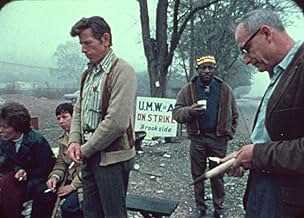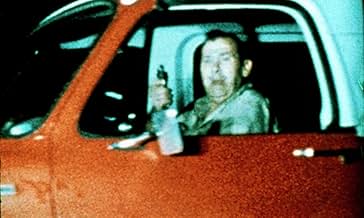Um registro comovente da luta de treze meses entre uma comunidade que luta para sobreviver e uma corporação dedicada aos resultados financeiros.Um registro comovente da luta de treze meses entre uma comunidade que luta para sobreviver e uma corporação dedicada aos resultados financeiros.Um registro comovente da luta de treze meses entre uma comunidade que luta para sobreviver e uma corporação dedicada aos resultados financeiros.
- Ganhou 1 Oscar
- 9 vitórias e 1 indicação no total
- Self - Pres., UMW, 1920-1960
- (cenas de arquivo)
- Self - Black Ling Clinic., W. Va
- (as Dr. Donald Rasmussen)
- Self
- (as Dr. Hawley Wells Jr.)
- Self - Pres., UMW, 1962-1972
- (cenas de arquivo)
- Self
- (cenas de arquivo)
- (as Joseph "Jock" Yablonski)
- Self - Mine Foreman
- (as Basil Collins)
Avaliações em destaque
I used to consider Gates of Heaven and Harlan County USA as in deadlock for the best documentary ever made, but upon watching Harlan County USA again and all the extras available on the Criterion DVD, I have no choice but to move it into the sole number One position. The sense of dread and danger of Harlan County USA elevates it to a whole new level, making it perhaps the most watchable documentary ever made as well - its tense subject matter and the incredible footage captured by Kopple and her crew make it play as a feature film. Kopple's intimate participatory style makes the film even more poignant. The film crew was there with the strikers, amidst the bullets and beatings, at one point being singled out for attack and were beaten by the mining company militants. That they were there meant that they got some absolutely incredible footage, such as the scene described above, and when they catch the main strike breaker pointing his gun at them on film.
Harlan County USA is also an important social document, now housed in the national film registry for preservation. Scenes such as children being washed in buckets, in the 1970s, in the "beacon of freedom and democracy" The United States of America, really get beyond the rhetoric and show how the government and the big business agenda often trumps the rights of workers - its about maximizing profits not lives.
4/4
I can't believe it was so recently that companies were hiring brutal men to terrorize their workers over money.
The movie is set in Harlan County, and there is not much to say but that you are watching history unfold, with all of it's rage and fire, and bloodshed, tears and strength.
Nothing is hidden and it is very powerful. People willing to die for what they believe in, it is very eye opening. The people were real, fearless, and their struggle raw.
There are real villains here, the gun toting hired thugs, and the company who seems OK with the way things are handled. Murdering poor people over a few cents and common sense benefits. Sad.
The most poignant memory of the film for me was how they tricked a truly injured man into coming back to the work site so that they could deny him worker's comp. Quite shocking.
This documentary was filmed over a period of 4 years which in turn showed the lack of speed for a change from a peon work ethic to one of equality. The men of the mine saw the results that a union in other parts of the country and the standard of living that most Americans enjoyed as compared to their own situation. The community of Harlan County had a desire for change from an almost forced labor to one where the worker could make choices, have health care and to not live from pay check to pay check. The men and the woman were willing to risk everything for a better future for their children. The wives of the minors not only lived in the same conditions but had the same drive for changes and a difference. The women not only increased the numbers for picket lines but they also brought the importance of the strike to an `at home' feel. The rough terrain, harsh living community, and dirty, dingy way of life that a miner and a miner's family lived in was adequately represented in the film via the raw nature of the interviews and the in the field live spontaneous coverage. You as the viewer did not sit back and watch the film but instead were brought in to the lives of these men and woman. The filming brought a sense to the audience that you were there on the picket line, you felt the terror of being attacked, and you experienced the chaos when shots were fired at unarmed citizens. The falling of the camera and the blackness of the shot exemplifies the nature of not understanding what was going on at that moment. This in your face type of filming also show all aspects of what a strike of this nature entails. The viewer saw the aftermath and hospitalization of the battles between unarmed men and the `gun -thugs' sent to end picket lines. Like Bordwall and Thompson state the film crew used was small and more mobile, this not only rejected the traditional ideals of script and structure but also allowed the film makers to almost disappear into the back ground and let the action unfold in font of their eyes. This form of filming were there is a no holds bar or in your face tactic shows all portions of the incident, meaning that there is a feeling that the camera was never turned off. It brought light to a subject that most would not have known about, a subject that it profoundly influenced. The press that such documentaries bring to these hidden incidents carries a strong level of change and importance that otherwise would not be there. The filming of these events is intense. The film must express the telling of a complete story, one that ties the events that previously unfolded through the elapsed filming time to a coherent ending, being it either good or bad. The documentary film is a modern day form of passing on a lesson or an experience to a new audience, the modern day word of mouth story telling.
This is a powerful Oscar-winning documentary produced and directed by Barbara Kopple ('American Dream', 'Wild Man Blues'). It focuses on the men at the Brookside Mine in Harlan, Kentucky who, in the summer of 1973, voted to join the United Mine Workers of America (UMWA). Duke Power Company and its subsidiary, Eastover Mining Company, refused to sign the contract. The miners came out on a long strike, registered by Kopple with testimonies, backstories, archival footage, and music, particularly that of Hazel Dickens during the final credits.
The film's main strength resides in the sincerity of its emotional, political and sociological core without being overtly sentimental, and Kopple's way of testifying instead of exploiting the subjects. The miners and their wives are not depicted in old hillbilly stereotypes, but rather as hard-working human beings fighting for their basic rights ('together we stand, divided we fall').
Thirty years after the release of this documentary, five miners died in an explosion at Harlan County. When the film was shot, money was the bigger issue (industry profits rose 170% in 1975, but miner's wages rose only 4%); nowadays, however, safety is an even bigger issue. You'd think things would have been largely improved since then, but that's not really the case. 'Harlan County U.S.A.' is a remarkable documentary because it testifies and proposes solutions about a public struggle that shouldn't be overlooked, yet has been for such a long time, in the "land of the free and home of the brave".
Você sabia?
- CuriosidadesWhen filming began, the film was intended to be about the 1972 campaign by Arnold Miller and Miners For Democracy to unseat UMWA president Tony Boyle, in the aftermath of Joseph Yablonski's murder; however, the Harlan County strike began and caused the filmmakers to change their principal subject, with the campaign and murder becoming secondary subjects.
- Citações
Hawley Wells Jr.: [...] that was when I learned my first real political lesson, about what happens when you take a position against the coal operators, against the capitalists... I found out that the union officials were working with the coal companies. I also found that the Catholic hierarchy was working with the coal companies. Here was a combination of the whole thing, you see: you had to bump against the whole combination of them.
- ConexõesFeatured in Cinéma Vérité: Defining the Moment (1999)
Principais escolhas
- How long is Harlan County U.S.A.?Fornecido pela Alexa
Detalhes
- Data de lançamento
- País de origem
- Central de atendimento oficial
- Idioma
- Também conhecido como
- Harlan County U.S.A.
- Locações de filme
- Empresa de produção
- Consulte mais créditos da empresa na IMDbPro
Contribua para esta página























